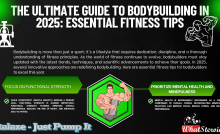How to Measure Training Effectiveness
Many athletes are unsure about the necessity to measure training and their success and, if yes, what is the right way to do it. This article is meant to answer these questions and give you precious advice on evaluating your results and keeping track of them.
Bodybuilders tend to evaluate the progress of training and muscle growth only by changing body weight. The fact they didn't know and didn't approach had many drawbacks. Firstly, it's hard to determine which weight has increased or decreased, whether muscle or fat.
A much more accurate way to rate the effectiveness of exercises is by measuring the volume of the body. If you are training for several months already and do not achieve the change in numbers, this suggests that the training program should be changed urgently as useless.
Must Read:: Beat Overtraining For More Muscle Gains
How Often do the Measurements have to be Repeated?
The complete measurement of body parts is sufficient to be carried out once every 4-6 weeks. You will not notice a significant difference if you do it more often. Also, remember that the measurements should be performed the same way as last.
After using the toilet, the best time to take measurements is in the morning. It's not recommended to rate immediately after training when muscles become more prominent because of the blood flow, as well as at the end of the day when swelling can be observed.
And now, let's specify exactly what has to be measured. One of the groups of muscles that have to be measured is the biceps, at its thickest point in the crook of the arm. Then is the chest at the level of the nipples during inspiration, forearm, wrist on the knuckles, neck in the middle, waist through the navel with normal breathing, leg in the middle, and tibia while standing on toes.
It is also necessary to measure the circumference of the hips and shoulders. You will need someone's help there, as you will not manage to do it yourself. Another aspect that must be recorded is your body weight at the time of measurement and your height. The height is enough to be taken once a year.
We have already mentioned that the measurements should be performed before training. Also, try not to strain your muscles during the measurements, and do not take too big breaths when measuring the chest and waist circumference.
Simple Body Measurement Technique
The measurement can be used as a measuring tape and paper tape with no divisions - in this case, you commit the first leg, then remove the measurement line (there is no temptation to cheat yourself by straining muscles or doing breath).


Measuring body fat is an action that also has to be performed regularly. To measure subcutaneous fat, you can use a simple mechanical device, electronic scale, and other devices to determine the body composition analyzer.
If you do not have such a device at home, you can find a solution quickly. I'm about healtI'mlubs or specialized centers where you can find professional equipment for determining fat level. Moreover, there is a big chance that household devices can be less accurate for such purposes.
As you see, monthly measurements of the most critical parameters of the body are essential steps in establishing the progress of training. Furthermore, an additional subcutaneous fat measurement shows either you get muscle or fat. So, do not neglect measurement and do it as precisely as possible. Get the exact numbers of your progress and rate how successful your training is.
A Coach's Guide to A Successful Learning Program
The first step to practical training is understanding your trainee's needs. For example, if you are a trainer and want to train someone on how to use specific equipment, then you should know what they need to learn and how they learn best. You can ask questions that will help you understand their learning style.
The next step is understanding the knowledge and skills that your learners need. This will help you plan what the training should cover and in what order it should be presented.
The third step is designing an effective training program for your learners. This includes ensuring that the environment where the training takes place is appropriate for learning, creating a schedule for each section of the movement, and determining what method of instruction will be most effective for your learners (lecture, discussion, or hands-on).
An Elaborate Training Schedule
Step 1
Understand the Learner's NeedsLearner'stheir learning style? What are they trying to learn?-How are knowledge and skills necessary for them to be successful in the job?-Who should attend this training program?-How many hours a day will it take for them to complete the training program by their preferred method of instruction?
Step 2
Understand Your Learner's KnowlLearner's; Skills.-What do they already know ?-What are their strengths, weaknesses, and transferable skills?
Step 3
Develop Your Training Program-What is the educational objective of the training? What are the business goals of your program?-What is it necessary for learners to know to be successful in this training program?
Step 4
Develop learning objectives that leverage learners' weaknesses. How will you engage learners and measure success during training? How will you assess learning objectives that meet your learner's needs? What learning activities will you use in this training program?
Step 5
Create a Training Program Curriculum.-What learning activities will be used for each section of the program?
Measuring Training Progress
Bodybuilding training progress is measured in a variety of ways. One way is to measure the amount of fat mass and muscle mass in the body. Since bodybuilding training can be long, it is essential to measure progress regularly. It can be measured by changes in weight, fat percentage, and lean muscle mass.
Some other good ways to measure progress include using weights. Bodybuilders do not typically use weight gauges during training. The weight is measured by the number of plates in a dumbbell or water in a gallon jug. As with other measurements, depending on what is being measured, it can be classified as either "total bodyweight" or "bodyweight." These terms "are used interchangeably when describing progress for bodybuilding training.
Bodyweight is the muscle mass that a person has. It is the weight a person can hold (excluding fat mass). Total body weight is a person's weight on their entire body, including fat mass.
Overall
When you are training for bodybuilding, it is crucial to measure your progress. This will help you see if you are on the right track and need to make any changes.
This article will give you an overview of how to measure your progress in bodybuilding training.
Measuring your progress in bodybuilding training is essential because it helps you see if you are on the right track and if there is anything that needs to be changed.
This article has provided an overview of how to measure your progress in bodybuilding training so that this can be done efficiently and effectively. Please follow our steps, and nothing could go wrong with your training.
Recent Posts
Creatine vs Myostatin: An Expert’s Analysis
Myostatin, a protein encoded by the MSTN gene, acts as a regulator of muscle growth.…
Raloxifene (Evista) 101: A Non-Surgical Solution for Gyno
Raloxifene, a selective estrogen receptor modulator (SERM), is one of the most valuable yet less…
Mastering Bodybuilding in 2025: Top Fitness Tips for Success
Bodybuilding is more than just a sport; it's a lifestyle that requires dedication, discipline, and…
Why Post-Cycle Therapy (PCT) Fails After a Nandrolone Cycle
Nandrolone, or Deca Durabolin, is an injectable anabolic steroid often used by bodybuilders during the…
Counteracting Anabolic Resistance with Adaptogens in Aging Men
As people age, maintaining muscle mass and strength becomes increasingly challenging due to a natural…
Tips on How to Store Peptides and HGH
When peptides are mixed with bacteriostatic water (BAC water), their longevity is highly influenced by…



